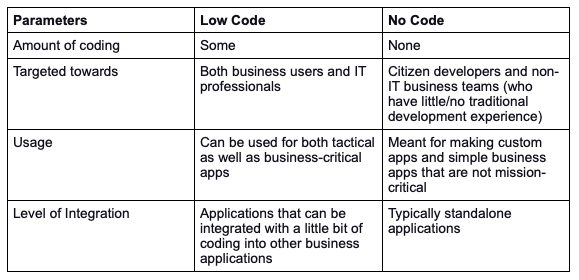Low Code is no longer a buzzword but an industry reality today. With industry reports suggesting a staggering $45.5 bn Low-Code market by 2025, Low Code application development is the tech platform of the future.
Table of Contents
ToggleBut why is Low Code gaining so much prominence? What are the key benefits to business leaders and companies from Low Code? Let’s dive deeper into this.
What is a Low Code Development Platform?
Let’s face it – software development has always been like magic for the layman. People imagine coding geniuses who deal in arcane “languages “and write mystical “programs” that create wonderful applications. But what if there was a way to help everyone create their software themselves?
That’s the promise of Low Code. Low Code development lets people with minimal software training create software in a visual/graphical way using simple drag-and-drop functionality.
Low code development makes it easy for even those not trained in software development to create robust, platform-agnostic, cloud-ready, and efficient applications.
Can you imagine not needing an army of coders to build apps or being able to develop rapid prototypes without using a team of experts?
That’s just the tip of the iceberg, my friend.
Here are the key benefits of low code application development that will make you a Low Code believer!
Benefits of Low Code
1. Improved Business Agility
With new challenges such as a remote workforce, an increasing need for automation, and the need for better UI/UX, agility is the need of the hour for enterprises.
Low-code platforms allow IT teams to build applications quickly and easily. It reduces the delivery time of new applications and the manpower needed to spend per application development.
IT teams are freer to make more complex applications, whereas even non-tech departments can create simpler applications to manage their teams.
451 research estimates that Low Code can even cut development time by 50%-90% instead of using it for better application development and a more friendly user interface.
2. Lower Costs
Low code development platforms allow seamless systems integration and cross-platform workflow automation. This reduces the traditional costs needed to maintain teams that do cross-platform development, integration, and testing.
Secondly, low-code platforms also reduce the cost of hiring development teams. Low-code platforms are also easier to maintain, reducing the need for a bloated IT team in a business.
Low Code is so effective that in a recent research study from Appian among tech companies that implemented Low Code, 42% realized cost savings! Such cost advantages are critical to success, especially for traditional businesses such as banks competing with newer upstarts from fintech.
3. Rapid Prototyping
The application development process requires creating multiple prototypes based on user feedback and revising the product until all feedback is incorporated.
Low-Code Development platforms allow faster development of quick and dirty prototypes, using the Rapid Application Development (RAD) model to create super-fast software.
Leveraging low code tools to create prototypes that users can interact with helps reduce functionality glitches, reduce the time taken for testing after the application is built, and creates more robust software. It also cuts down the time and resources needed to develop software.
4. Faster Transformation
Businesses are slowly replacing traditional IT infrastructure with modern technology. For example, banks are coming out of the days of mainframes and moving their applications to the cloud. The need to adapt to a new kind of customer is driving these decisions.
However, such digital transformation is not easy and is certainly never cheap. You need an army of developers and people who can interface between old and new technologies. Such talent is hard to find and harder to retain.
Low Code helps enable digital transformation. Low Code provides a platform-agnostic layer that can interact between old and new technologies and quickly build applications without needing a big team, unlike traditional software development.
5. MultiExperience Made Easy
Customer satisfaction is the most elusive goal for most businesses. The best way to ensure that is by enabling potential and existing customers to interact with you in a way that is easiest for them to work with. Gartner calls this “Multiexperience.”
This includes multiple touchpoints for customers: chatbots that are easy to use, cloud-enabled apps that provide functionality that is as powerful as legacy apps they are used to, and so on.
Research suggests that the market for multiexperience applications is growing at 18.2% per annum, confirming the demand for these applications. But all this calls for big budgets and major investments.
With Low Code, even small businesses can get on the bandwagon of multiexperience. Low Code lets you deliver seamless customer interfaces that let users interact with your systems without having to relearn them in every new step.
6. Cloud Hosting
We talked about this earlier, but we can’t stress this enough – if you are looking at cloud-based applications, there is nothing like a Low-Code development tool to turbocharge your application creation process.
Low Code applications are agile – you can make full-stack applications in days and make changes to them in a matter of minutes. You can develop world-class cloud applications with shoestring budgets.
What’s more, you can use Low Code to create a market-facing application that integrates easily with your legacy solutions.
7. Cross-Platform Capabilities
Wouldn’t you love it if you could build the same application on mobile, tabs, PCs, and so on without having to code it separately for each platform?
Unfortunately, building cross-platform capabilities is usually time-consuming and difficult. With Low Code, you can create single-click cross-platform deployments.
You can also make changes that reflect across platforms simultaneously, rather than having to code them separately in each platform.
8. Legacy Integration
Legacy systems are a quagmire of inefficient coding, unscalable architecture, and systems that are difficult to adapt to newer technologies.
Low code helps integrate these legacy systems built on traditional methods of coding with newer technologies in a quicker, cheaper, and cleaner way.
9. Less Maintenance
Low-Code app development uses pre-built components, templates, and modules. These templates are already tested across applications and require less maintenance and testing. This reduces the need for traditional hand-coding of application modules.
Low Code also allows IT teams to set boundaries around the application during development itself, thus requiring lesser time to test and inspect later.
More than that, Low Code modules are standardized; therefore, new coders can quickly come to understand them and will not need to spend hours trying to understand the code.
10. The End of Shadow IT
Shadow IT is a term used by IT teams to refer to low-quality workarounds and applications that business users build to keep business moving without discussing it with the actual IT experts.
Such applications might seem to be “doing the job,” but they are, in fact, offering a poor solution to a real problem. Alas, shadow IT is very much here to stay because the demand for business applications is now more than five times what IT teams can produce.
This might yield a poor customer experience, especially one that is out of sync with the multiexperience concept that companies strive for.
With Low Code platforms, business users can create simple applications that are seamless yet do not require intervention from IT teams who are overburdened with bigger projects.
11. Better Governance
Low-Code app development has centralized governance modules that can manage all the Low-Code projects in an organization from a single screen.
Not just projects, but you can also manage users, security systems, environments, and much more. Multiple teams can work seamlessly using this central console without “breaking” each other’s applications.
12. Innovation For All
A Gartner survey suggests that businesses cannot create 64% of new business apps they want to automate business processes, because there simply aren’t enough skilled professional developers available to them.
In such a scenario, letting the less involved and mundane application development go to business users supported with a Low-Code solution and augmented with light tech support is key to moving forward.
What’s the Difference Between Low Code and No Code?
People often use the terms Low-Code and No-Code platforms interchangeably, but they have significant differences. Either option has its own advantages, but here are a few fundamental differences between the two approaches:

Most importantly, while the benefits of Low-code/no-code development platforms remain largely similar, however, their applications are very different.
Challenges of Low Code Platforms
While the use of low-code development platforms can be beneficial to business users, there are challenges involved.
The biggest challenge right now is that very few professional developers are comfortable using Low Code. While Low code platforms make it easier to develop application software, they are not completely devoid of coding – and very few skilled developers are Low Code experts.
Another problem that crops up sometimes is that Low Code generates excessive underlying code that can affect the optimization and performance of its applications.
Users tend to misinterpret Low Code as a panacea to all their coding needs, but it works best in specific use cases. Businesses should not use Low Code to create solutions for complex business problems.
Low Code Is Here To Stay
Low code solves real problems like rapid application deployment, lowering costs, addressing the shortage of IT talent, and much more. Low Code applications are cloud-ready, platform-agnostic, and easily integrable into your existing IT infrastructure.
